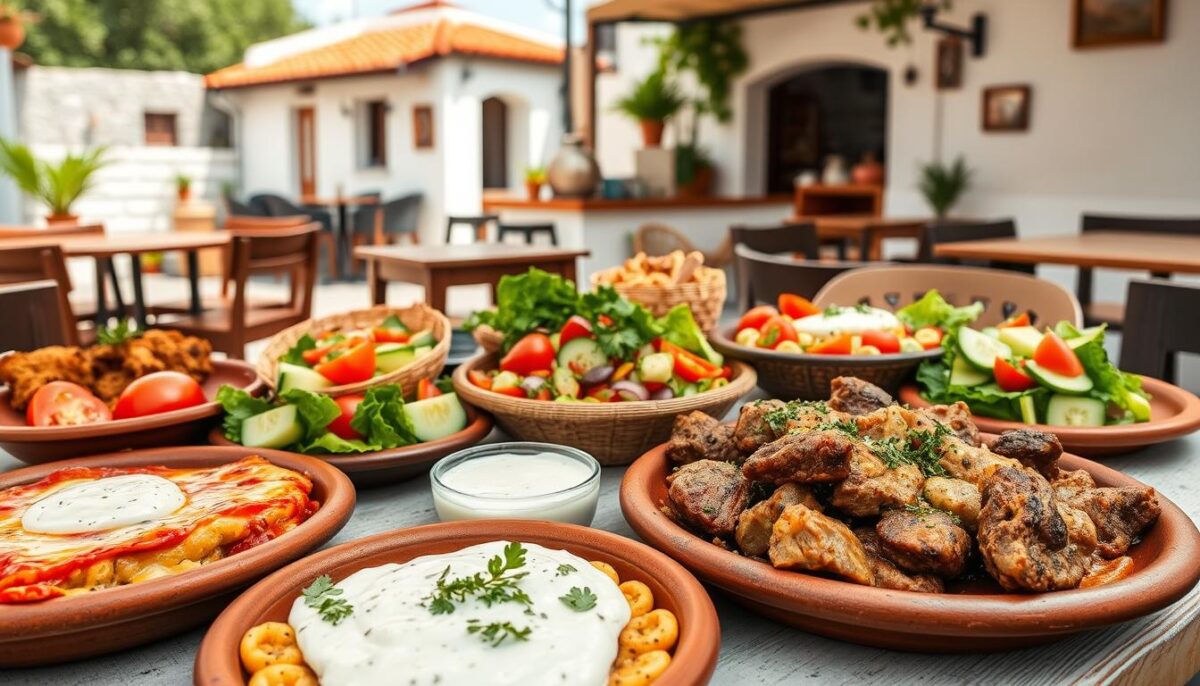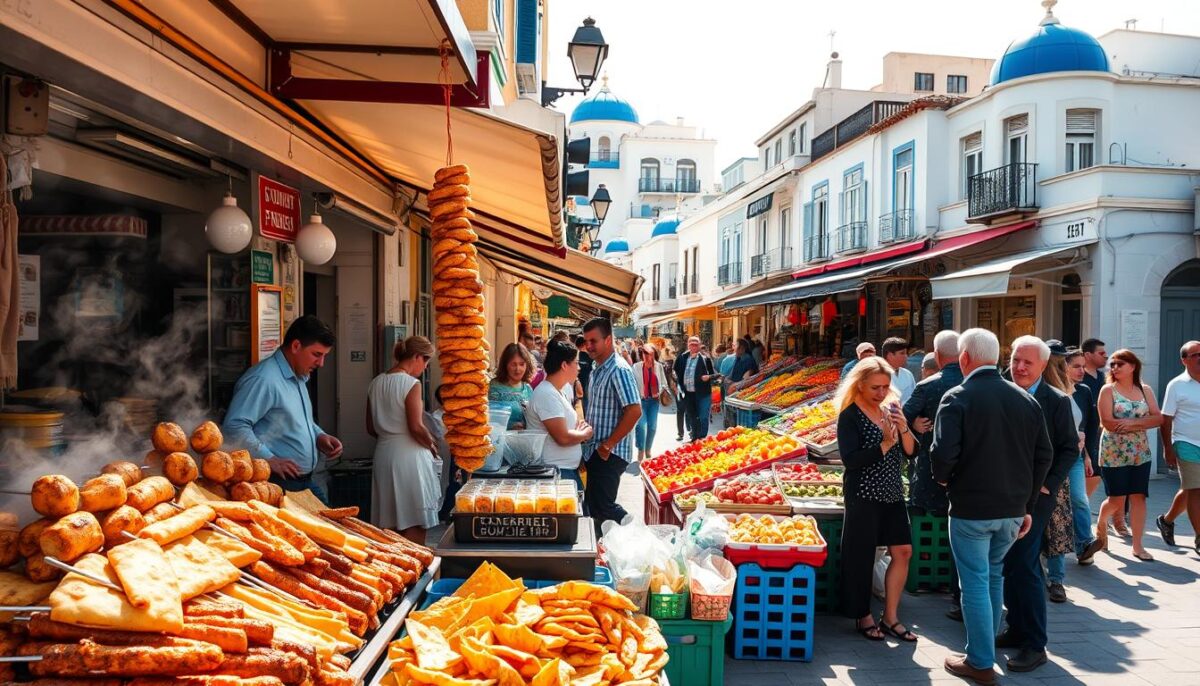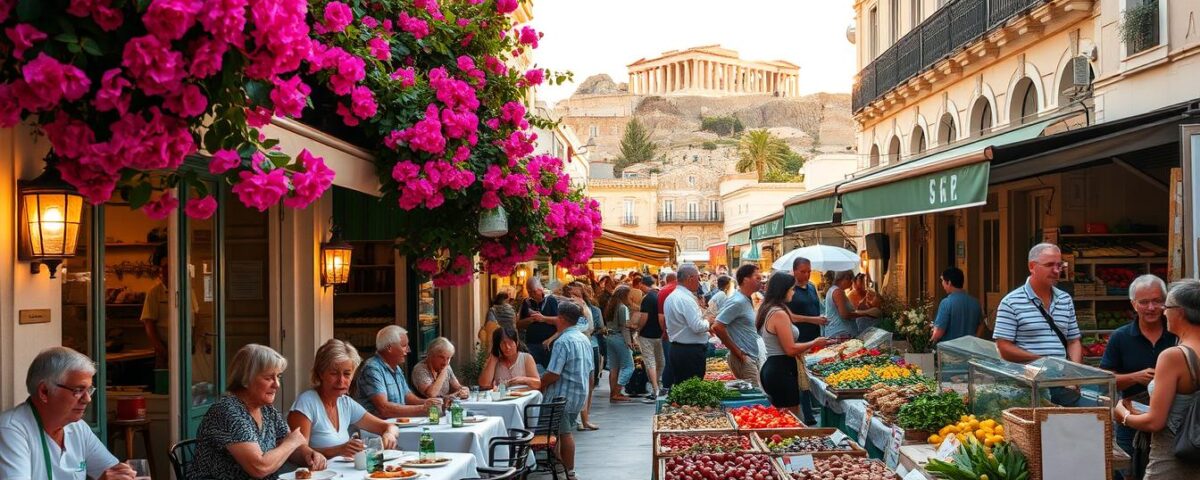
5 Essential Stops for a Food Lover Visiting Mexico City
June 9, 2025
What to Taste in Prague If You Want the Real Czech Experience
June 10, 2025Did you know over 80% of visitors to Greece’s capital never taste authentic loukoumades? I learned this the hard way during my first trip. My mission was simple: savor the real flavors of this historic city, not the reheated gyros sold on every corner.
I arrived eager to dive into family-run tavernas and bustling markets. But neon signs shouting “Tourist Specials!” made it tricky. One afternoon, a shopkeeper whispered directions to a hole-in-the-wall spot. There, I discovered spanakopita so flaky, it shattered like autumn leaves—a far cry from the soggy versions I’d tried earlier.
What defines “eating local” here? It’s not just about ingredients. It’s olive oil pressed by the same family for generations. It’s the baker who remembers your coffee order. Through trial and error, I uncovered secrets that transformed my meals from generic to unforgettable.
Key Takeaways
- Authentic eateries often hide in plain sight, away from major squares
- Freshly pressed olive oil signals quality in traditional dishes
- Street vendors with long lines usually offer the best value
- Morning markets reveal daily culinary rhythms
- Conversations with shop owners unlock hidden gems
Embracing the Athenian Breakfast Culture
The secret to a true Athenian morning lies in a paper-wrapped snack and strong coffee. Most residents don’t linger over plates—they fuel up while walking to work. My first attempt to keep pace left me breathless but rewarded with flaky cheese pies still warm from the oven.
Grabbing a Koulouri and Street Pies on the Go
I learned to spot the best vendors by watching office crowds. A koulouri—a sesame-crusted bread ring—became my daily ritual. One baker chuckled as I fumbled coins, handing me a spiral-shaped pie oozing with spinach and olive oil. “Real fuel,” he winked.
Street carts here operate like pit stops. Meat-filled tiropitas share space with sweet custard triangles. The best ones leave glossy oil stains on napkins—a mark of quality. I still dream about a sausage-wrapped pastry I grabbed near Syntagma Square.
My Favorite Local Bakery Finds
An alleyway scent led me to a basement bakery humming at dawn. Shelves groaned under loaves brushed with olive oil and honey. The owner pressed a free spanakopita into my palm—her way of welcoming newcomers.
| Breakfast Item | Key Ingredients | Best Time |
|---|---|---|
| Koulouri | Sesame, flour, yeast | 7-9 AM |
| Cheese Pie | Feta, phyllo, olive oil | All morning |
| Meat Pie | Ground beef, herbs | Peak lunch rush |
These humble bites reveal the city’s heartbeat. A street breakfast isn’t just food—it’s a masterclass in efficiency and flavor. Now I judge bakeries by their crust’s crispness and the warmth of their counter staff.
Athens local food tips: Navigating the City Restaurant Scene
Finding genuine eateries here feels like decoding a culinary treasure map. During my first week, I nearly gave up after three underwhelming meals. Then a fruit vendor changed everything by scribbling directions to her cousin’s taverna on my receipt.

Relying on Local Recommendations and Reviews
I learned to ask workers, not hotel staff, for suggestions. A bookstore clerk once whispered about a basement kitchen serving stuffed tomatoes with century-old recipes. These spots rarely appear on “top 10” lists but consistently deliver vibrant flavors.
Online reviews helped too—I prioritized comments mentioning family recipes or olive oil brands. One couple’s blog led me to a hillside café where the owner presses his own olives. Their time-honored methods transformed simple ingredients into magic.
Using Food Tours for Authentic Experiences
A guided tour became my cheat code for bypassing tourist traps. Our group sampled dishes in a 1920s deli and a modern bistro using ancient grains. The guide—a third-generation Athenian—explained how people here prioritize quality over speed.
We tasted olive-infused dips beside grandmothers shopping for dinner. Unlike solo adventures, these tours revealed hidden courtyards and seasonal specials. I still swap restaurant tips with friends made that day.
Key lessons? Trust time-tested eateries with loyal regulars. Seek places where ingredients shine brighter than decor. And remember—the best meals often begin with asking, “Where would you eat tonight?”
Exploring Authentic Home Cooked Meals in Athens
Rolling dough in a sunlit kitchen while a grandmother critiques my technique changed how I view Greek cuisine forever. Beyond restaurants, the city’s soul lives in home kitchens where recipes pass through generations. I discovered this through immersive cooking classes and countryside visits—moments that turned meals into cultural exchanges.
Cooking Classes and Dinner Experiences
At a family-run workshop, I kneaded dough for horiatiko psomi—rustic village bread baked in clay ovens. Our instructor Maria laughed as I over-stuffed spinach pies, whispering, “More filling means more love.” The golden crusts we created carried the taste of centuries-old traditions.
Day Trips Featuring Home Buffet Feasts
A day trip to a Peloponnese farm introduced me to tables groaning under roasted lamb and herb-infused dips. The hostess piled my plate with spinach-studded pies, insisting I try “real portions.” Unlike restaurant meals, this feast unfolded over hours, with stories shared between courses.
| Experience Type | Highlights | Best For |
|---|---|---|
| Cooking Classes | Hands-on preparation, recipe secrets | Skill-building |
| Home Dinners | Multi-course meals, family stories | Cultural immersion |
| Farm Visits | Fresh ingredients, rural settings | Nature lovers |
These experiences taught me that Greek meals are conversations, not transactions. The warmth of shared bread and the pride in each dish’s taste created memories no Michelin star could match. Booking through vetted platforms ensures genuine encounters—look for hosts who emphasize seasonal ingredients and leisurely pacing.
Dining Late: Understanding the Athenian Meal Times
My stomach growled angrily at 6 PM as I wandered past shuttered restaurants. That’s when I discovered Greeks treat dinner like theater—the curtain rises late. Locals savor meals when moonlight bathes the Acropolis, transforming nourishment into nightly celebration.
How I Adapted to Late Night Dinners
I shifted my rhythm like adjusting to a new time zone. Light lunches at market stalls became crucial—think tangy feta cubes and cherry tomatoes. By 8 PM, the city awakened. Tavernas buzzed with families debating politics over shared plates.
One evening near Monastiraki Square, I joined locals clinking glasses under string lights. Waiters delivered sizzling saganaki cheese as street musicians played. The energy felt electric—meals here aren’t just food, but the pulse of life after dark.
Planning My Day Around the Greek Dining Schedule
I mastered the art of strategic snacking:
- Grabbing breakfast pies by 10 AM
- Nibbling olives at sunset markets
- Reserving dinners for 9 PM starry skies
Varvakios market taught me night shopping secrets. Butchers joked with regulars as I selected figs for midnight desserts. Pro tip: Book evening places in advance—prime tables vanish faster than baklava at a family gathering.
Adapting to this rhythm deepened my connection to the city’s heartbeat. Meals became languid affairs where night unfolded in courses. Now, I can’t imagine dining before the first stars appear.
Savoring Street Food and Casual Eats
The sizzle of meat on a charcoal grill became my compass through the city’s maze of flavors. Street vendors here craft culinary masterpieces wrapped in paper—each bite whispering stories of tradition. My journey began with determined searches for perfect souvlaki, but quickly became a celebration of spontaneous discoveries.

Discovering Iconic Souvlaki and Gyros Spots
I followed smoky trails to a corner stall where skewers turned like clockwork. The cook grinned as I ordered “everything” – juicy pork nestled in pillowy pita, dripping with garlicky yogurt. This wasn’t fast food; it was a course in balance, perfected over years.
| Street Food | Best Spot Clue | Must-Try Twist |
|---|---|---|
| Souvlaki | Look for rotating skewers | Extra lemon squeeze |
| Gyros | Follow office worker lines | Add fried potatoes |
| Koulouri | Morning metro exits | Pair with sesame dip |
Happy Accidents: Unplanned Finds on the Streets
A wrong turn led me to an alley where grandmothers debated over crispy tiropita. One thrust a cheese-filled triangle into my hand – its flaky layers singing with love for the craft. Later, I learned to always carry ouzo – a sip cuts through rich flavors like sunshine through clouds.
My favorite thing? How a three-euro snack could eclipse fancy meals. The secret lies in years-honored recipes passed between generations. Now I seek carts where locals cluster, knowing the real magic happens off-menu. Pro tip: Let your nose guide you – the best course often starts with a whiff of charred herbs.
Modern Twists: Michelin-Star Dining and Upscale Adventures
Dining at CTC Urban Gastronomy felt like watching a master painter rework a classic canvas. Amidst the city’s vibrant street food scene, this Michelin-starred gem revealed how tradition could dance with innovation. Their tasting menu transformed familiar flavors into edible poetry.
When Classics Meet Culinary Alchemy
The chef’s reinterpreted spinach pie arrived as a translucent phyllo sphere, bursting with wild greens and smoked cheese. But the real showstopper? Feta cheese whipped into airy foam, layered with candied lemon peel. Each course felt like decoding a delicious riddle—recognizable roots with avant-garde flair.
Their blind tasting menu became my favorite gamble. Twelve courses paired ancient grains with molecular techniques. One bite transported me from a central Athens dining room to a Cycladic hillside at dawn.
Securing Your Seat at the Table
Booking requires strategy:
- Reserve 6+ weeks ahead—tables vanish faster than loukoumades at a festival
- Mention dietary needs when reserving—menus adapt brilliantly
- Opt for counter seats to watch the kitchen’s ballet
While pricier than street food joints, the experience redefined my understanding of greek food. As I sipped mastiha-infused dessert wine, I realized gourmet dining here isn’t about replacing tradition—it’s writing its next chapter.
Uncovering Local Markets and Artisan Ingredients
The scent of freshly ground coffee beans led me through Varvakios Market’s labyrinth of stalls. Crates overflowed with plump olives and mountains of oregano, while butchers bantered with regulars. This wasn’t shopping—it was a masterclass in how ingredients shape a city’s flavors.
Exploring Varvakios Market and Other Hotspots
My first visit felt overwhelming until a vendor handed me a fig. Its honeyed sweetness became my compass. I learned to watch for:
• Olive sellers offering tasting spoons
• Spice merchants explaining herb pairings
• Cheese counters with salad-ready chunks of feta
One morning, a fishmonger taught me to spot glistening eyes on sardines—his secret for freshness. Nearby, a coffee stall brewed thick Greek blends that could jumpstart a statue. “Fuel for your trip,” the owner grinned, sliding me a porcelain cup.
| Market | Specialty | Best For |
|---|---|---|
| Varvakios | Meat & seafood | Morning visits |
| Central Municipal | Organic produce | Seasonal finds |
| Monastiraki Flea | Spices & herbs | Unique souvenirs |
These hubs taught me that flavors tell stories. The peppery kick of Kalamata olives? A hillside grove’s legacy. Crimson saffron threads? A family’s generational craft. Now I plan market stops first when mapping any trip—they’re living guides to regional cuisine.
Pro tip: Grab salad fixings by noon. The juiciest tomatoes vanish faster than sunset over the Acropolis.
Eating Like a Local: The Role of Meze and Traditional Drinks
The clink of ice cubes in a cloudy glass signaled my initiation into Greece’s most cherished ritual. Meze—small plates meant for sharing—turned strangers into friends and meals into celebrations. I discovered these social bites aren’t just dishes, but invitations to linger, laugh, and live like those who call this place home.
Sharing Meze Platters and Ouzo Rituals
At a dimly lit taverna near Psyrri, a waiter placed a “family-style” platter between me and three new acquaintances. Crumbled feta swam in golden olive oil beside smoky eggplant dip. Each bite came with a sip of ouzo—its anise kick clearing the palate for the next flavor adventure.
Locals taught me to order meze in waves. Start with briny olives and creamy tzatziki. Progress to grilled octopus drizzled with lemon. Save honey-dipped feta for last. This rhythm transforms simple snacks into a meal stretching past midnight.
Coffee Culture and Sweet Finales
Morning fuel here comes in tiny cups. I learned to order “ellinikós”—thick Greek coffee served with a glass of water. Pair it with meze-style pastries like baklava oozing pistachio filling. The contrast of bitter brew and syrupy sweetness became my daily ritual.
| Meze Dish | Perfect Pairing | Best Occasion |
|---|---|---|
| Feta-stuffed peppers | Ouzo on ice | Sunset gatherings |
| Fried zucchini balls | Cretan white wine | Midday breaks |
| Walnut cake | Mastiha liqueur | Post-meal treats |
Seek restaurants where meze plates outnumber entrées on menus. These spots prioritize community over courses. Pro tip: Let servers guide your selection—their choices often reveal hidden gems not listed. Through shared plates and clinking glasses, I tasted the true essence of Greek hospitality.
Conclusion
My culinary journey through Greece’s capital taught me that every bite tells a story. From flaky morning pies at metro stops to Michelin-starred reimaginations of classic dishes, each meal became a passport to deeper connections. The sizzle of street grills and clatter of family kitchens revealed how dining here weaves tradition into daily life.
What stays with me? The way a simple dish of stewed greens could spark conversations spanning generations. How home cooks measure ingredients in handfuls and heartbeats. Even upscale tasting menus carried echoes of age-old recipes—proof that innovation roots itself in culture.
To truly taste this city, embrace contrasts. Hunt crispy phyllo in alley bakeries, then savor avant-garde olive oil foams. Let market vendors guide your shopping list. Most importantly, share plates freely—meals here thrive on generosity.
As I packed my suitcase, I realized these flavors had reshaped my palate. The city’s dining scene isn’t just about sustenance—it’s a living museum where every bite preserves history while inviting reinvention. My gratitude stretches warmer than fresh spanakopita, sweeter than baklava’s golden syrup. Here’s to meals that transform visitors into storytellers.
FAQ
How do I avoid touristy restaurants while exploring Athenian cuisine?
Skip spots with translated menus or hawkers outside. Instead, follow locals to family-run tavernas in neighborhoods like Koukaki or Psirri. I always check Google reviews tagged “hidden gem” and ask hotel staff for off-radar picks like Taverna Tou Psirri.
What’s a quick breakfast option that locals love?
Grab a sesame-coated koulouri (ring-shaped bread) from street vendors near metro stations. Pair it with a freddo cappuccino from Mokka or a spinach pie from Ariston Bakery—my go-to fuel for mornings.
How late do people typically eat dinner here?
Meals start around 9–10 PM. I adjusted by having a light meze snack at 6 PM, like feta-stuffed peppers at a café. Plan sightseeing breaks to align with the relaxed dining rhythm.
What street food should I absolutely try?
Don’t miss souvlaki wrapped in pillowy pita from Kostas or O Thanasis. For dessert, hunt down loukoumades (honey dumplings) at Lukumades in Monastiraki—crispy, sweet, and addictive.
Can I experience home-cooked meals without knowing a local?
Yes! Join cooking classes like “CookinAthens” or book a supper club through EatWith. I still dream about the lemon-infused lamb I made during a class in Kolonaki.
Where do locals shop for fresh ingredients?
Varvakios Market is a sensory overload of olives, spices, and seafood. For cheese, hit “Tyris” near Syntagma. I snagged aged graviera there—perfect with a drizzle of Cretan honey.
How do I navigate meze culture without overordering?
Share small plates like tzatziki, dolmades, and grilled octopus. Pair them with ouzo or tsipouro. At places like Oineas, servers often guide portions—trust their advice!
Any tips for upscale dining without the stuffiness?
CTC Urban Gastronomy blends innovation with tradition—their smoked eggplant with tahini foam blew my mind. Book 3 weeks ahead and dress smart-casual. No flip-flops!



